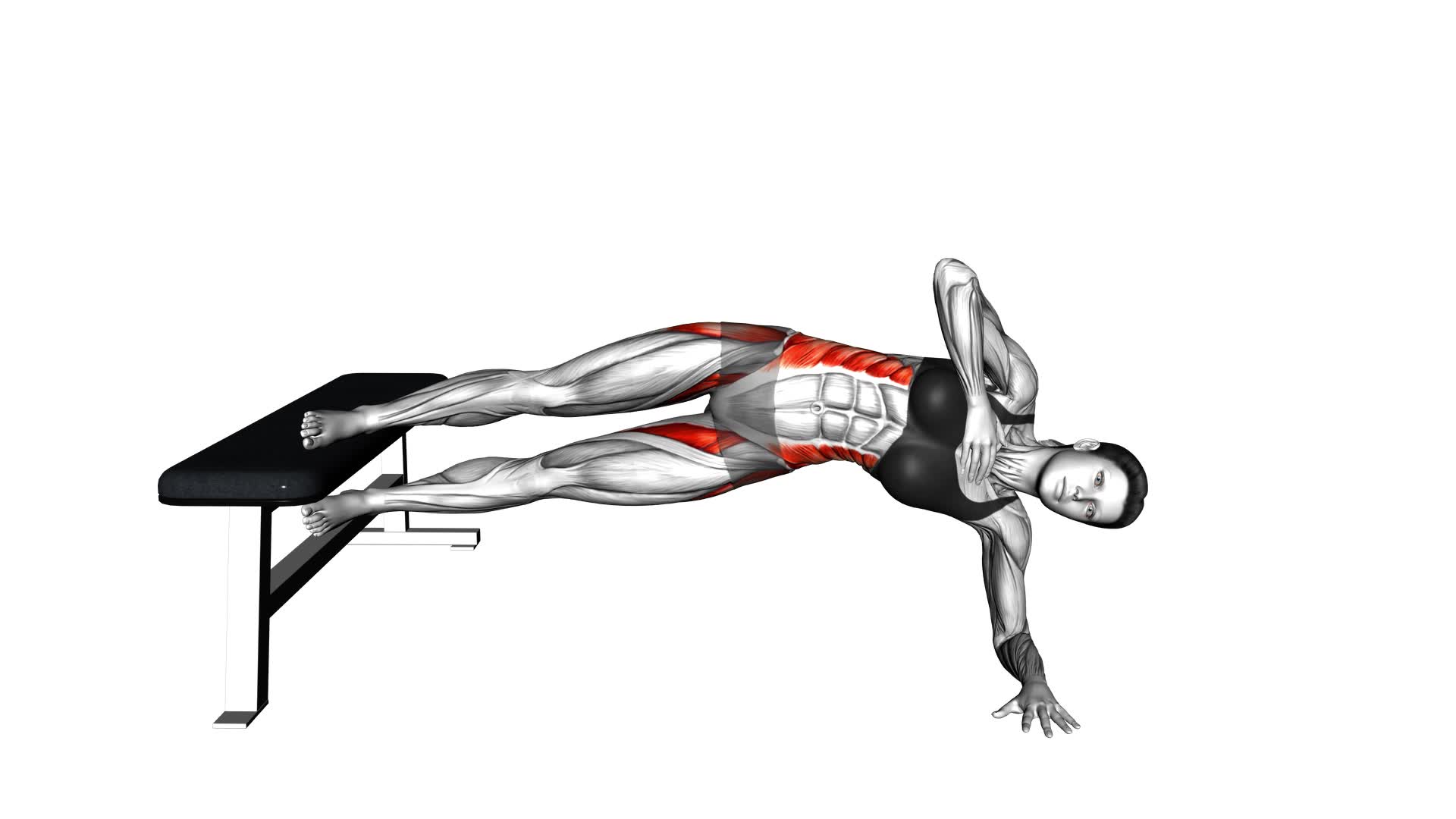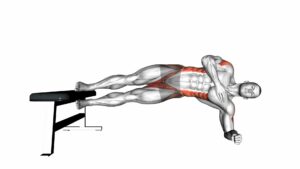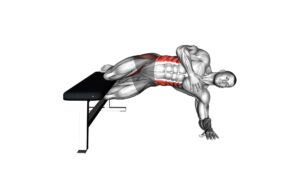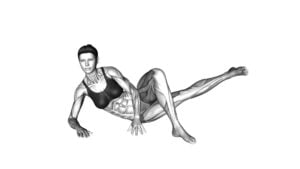Side Plank Hip Adduction (female) – Video Exercise Guide & Tips

Looking to strengthen your core and tone your hips? Check out our video exercise guide for Side Plank Hip Adduction.
Watch This Exercise Video
This challenging move targets your obliques and hip muscles, helping to improve stability and balance. In this guide, we'll show you the proper form, common mistakes to avoid, and modifications for all fitness levels.
Maximize your results with our expert tips. Get ready to feel the burn and achieve your fitness goals with this effective exercise.
Key Takeaways
- Side Plank Hip Adduction targets obliques and hip muscles, strengthening and toning the hips and core.
- Proper form includes lying on your side with legs extended and stacked, lifting the hips to form a straight line, and engaging the core while lifting the top leg across the body.
- Common mistakes to avoid include allowing the hips to sag or drop, rushing through the exercise, improper positioning of the supporting arm, neglecting proper breathing technique, and lack of control and balance.
- Modifications for all fitness levels include performing the exercise on knees instead of feet for beginners, using resistance bands or ankle weights for added resistance, utilizing stability balls or benches for extra support and balance, and customizing the exercise to individual fitness levels and goals.
Benefits of Side Plank Hip Adduction
The side plank hip adduction exercise offers a variety of benefits for women who incorporate it into their fitness routine. This exercise specifically targets the muscles in the hips and core, making it an effective way to strengthen and tone those areas. By engaging the hip adductors, which are responsible for bringing the legs inward, this exercise helps to improve stability and balance.
Additionally, the side plank hip adduction exercise can also enhance overall core strength, as it requires the muscles in the abdomen and lower back to work together to maintain proper form.
To perform the side plank hip adduction exercise with proper form, start by lying on your side with your legs extended and stacked on top of each other. Rest on your forearm, ensuring that your elbow is directly beneath your shoulder. Lift your hips off the ground, forming a straight line from your head to your feet. Then, engage your core and lift your top leg, bringing it across your body and toward your bottom leg. Slowly return to the starting position and repeat on the other side.
Incorporating the side plank hip adduction exercise into your fitness routine can help you improve hip and core strength, stability, and balance. Practice proper form to maximize the benefits and avoid injury.
Proper Form for Side Plank Hip Adduction
To perform the side plank hip adduction exercise with proper form, you need to focus on maintaining a straight line from your head to your feet and engaging your core muscles throughout the movement. This exercise is a great way to strengthen your hips and improve stability.
Start by lying on your side with your forearm on the ground and your feet stacked on top of each other. Lift your hips off the ground, creating a straight line from your head to your feet.
From this position, slowly lift your top leg, keeping it straight, and bring it forward, crossing over your bottom leg. Then, lower your leg back to starting position. Repeat this movement for the desired number of repetitions and then switch sides.
It's important to keep your core engaged and your body stable throughout the exercise. By incorporating side plank variations like the hip adduction, you can effectively target and strengthen your hips.
Now let's move on to the next section to discuss some common mistakes to avoid.
Common Mistakes to Avoid
When performing the side plank hip adduction exercise, it's important to be mindful of common mistakes to avoid that can hinder your progress and results. By understanding these mistakes and implementing proper technique, you can maximize the benefits of this exercise.
One common mistake is allowing your hips to sag or drop during the exercise. This not only reduces the effectiveness of the workout but also puts strain on your lower back. To avoid this, engage your core muscles and keep your body in a straight line from head to toe.
Another mistake to avoid is rushing through the exercise. It's important to maintain control and perform the movement with slow and controlled motions. This allows you to fully engage the muscles and prevents any jerky or unbalanced movements.
Improper positioning of the supporting arm is also a common mistake. Make sure your forearm is directly below your shoulder and your elbow is at a 90-degree angle. This provides stability and support throughout the exercise.
Lastly, avoid neglecting the proper breathing technique. Breathe in deeply through your nose as you prepare for the movement, and exhale through your mouth as you perform the hip adduction.
Modifications for All Fitness Levels
For all fitness levels, there are several modifications available for the side plank hip adduction exercise. Whether you're a beginner or an advanced exerciser, there are progression options and equipment variations that can help you tailor the exercise to your specific needs.
If you're new to the side plank hip adduction, you can start by performing the exercise on your knees instead of your feet. This will reduce the difficulty and allow you to focus on proper form and technique. As you gain strength and stability, you can progress to doing the exercise on your feet.
Another modification option is to use a resistance band or ankle weights to add extra resistance to the exercise. This will challenge your muscles even more and help you build strength in your hips and core.
Additionally, if you find it difficult to maintain balance in the side plank position, you can use a stability ball or a bench to support your body. This will provide extra stability and allow you to focus on the hip adduction movement.
By incorporating these modifications, you can customize the side plank hip adduction exercise to your fitness level and goals.
Now, let's move on to the next section where we'll discuss some tips for maximizing your results.
Tips for Maximizing Results
To maximize your results with the side plank hip adduction exercise, focus on engaging your core and maintaining proper form throughout the movement. Here are four tips to help you maximize efficiency and incorporate variations into your routine:
- Engage your core: Before starting the exercise, make sure to engage your core muscles by pulling your belly button towards your spine. This will help stabilize your body and improve the effectiveness of the exercise.
- Maintain proper form: Throughout the exercise, it's important to maintain proper form to target the correct muscles and prevent injury. Keep your body in a straight line from head to toe, and avoid sagging or arching your back.
- Control the movement: Slow and controlled movements are key to maximizing the effectiveness of the side plank hip adduction exercise. Avoid rushing through the exercise and focus on squeezing your hip muscles as you bring your leg up towards your chest.
- Incorporate variations: To challenge your muscles and prevent plateaus, try incorporating variations of the side plank hip adduction exercise. You can increase the difficulty by using ankle weights, or by adding a leg lift at the top of the movement.
Frequently Asked Questions
Is Side Plank Hip Adduction Safe for Individuals With Lower Back Pain?
If you have lower back pain, it's important to be cautious when choosing exercises. While side plank hip adduction can be effective for core strength, it may put strain on the lower back.
It's recommended to consult with a healthcare professional or a certified trainer for suitable alternatives and lower back pain exercises. There are plenty of alternative core workouts that can target the abs without aggravating your lower back.
How Many Calories Can I Expect to Burn by Doing Side Plank Hip Adduction?
To determine how many calories you can expect to burn by doing side plank hip adduction, it's important to consider the effectiveness of this exercise. Side plank hip adduction engages multiple muscle groups, including the core and hip muscles, which can contribute to calorie burn.
However, the exact number of calories burned will vary depending on factors such as your weight, intensity, and duration of the exercise. To get a more accurate estimate, you may consider using a fitness tracker or consulting with a professional.
Can Side Plank Hip Adduction Help Improve Posture?
Side plank hip adduction is an exercise that you can do to help improve your posture. By engaging your core muscles and stabilizing your body in a side plank position, you can strengthen the muscles that support your spine and promote proper alignment.
This exercise also helps to improve flexibility and prevent injury by targeting the muscles in your hips and thighs. Incorporating side plank hip adduction into your fitness routine can have a positive impact on your overall posture.
Is It Necessary to Use a Resistance Band While Performing Side Plank Hip Adduction?
To answer your question, no, it isn't necessary to use a resistance band while performing side plank hip adduction.
There are alternatives you can try if you don't have a resistance band, such as using ankle weights or a stability ball.
Additionally, beginners can modify the exercise by starting with a bent knee position or performing the movement without any added resistance.
Remember to listen to your body and choose the option that works best for you.
Will Side Plank Hip Adduction Specifically Target and Tone My Obliques?
Side plank hip adduction is a great exercise for targeting and toning your obliques. By engaging your core and lifting your hips, you're specifically targeting those side muscles. It's an effective way to strengthen and define your obliques.
If you're looking for alternatives, you can try exercises like Russian twists, bicycle crunches, or wood chops, which also work your obliques. Remember to maintain proper form and gradually increase the intensity for the best results.
Conclusion
To conclude, side plank hip adduction is a beneficial exercise for strengthening the hips and core. By maintaining proper form and avoiding common mistakes, you can maximize the effectiveness of this exercise.
Additionally, modifications are available to suit various fitness levels. By following these tips and consistently performing side plank hip adduction, you can achieve optimal results in your fitness routine.

Author
Years ago, the spark of my life’s passion ignited in my mind the moment I stepped into the local gym for the first time. The inaugural bead of perspiration, the initial endeavor, the very first surge of endorphins, and a sense of pride that washed over me post-workout marked the beginning of my deep-seated interest in strength sports, fitness, and sports nutrition. This very curiosity blossomed rapidly into a profound fascination, propelling me to earn a Master’s degree in Physical Education from the Academy of Physical Education in Krakow, followed by a Sports Manager diploma from the Jagiellonian University. My journey of growth led me to gain more specialized qualifications, such as being a certified personal trainer with a focus on sports dietetics, a lifeguard, and an instructor for wellness and corrective gymnastics. Theoretical knowledge paired seamlessly with practical experience, reinforcing my belief that the transformation of individuals under my guidance was also a reflection of my personal growth. This belief holds true even today. Each day, I strive to push the boundaries and explore new realms. These realms gently elevate me to greater heights. The unique combination of passion for my field and the continuous quest for growth fuels my drive to break new ground.







